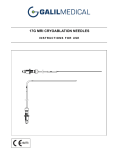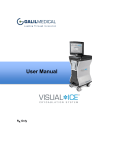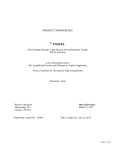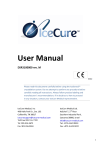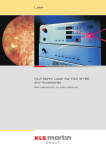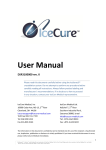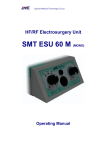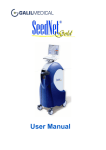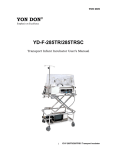Download IceRod CX Cryoablation Needles - Instructions for
Transcript
ICEROD® CX CRYOABLATION NEEDLES I NS TR U CTI ONS FOR U S E 0473 CE Mark of Conformity Do not reuse Use by Batch code Date of manufacture Sterilization using ethylene oxide Catalog number Consult instructions for use Manufacturer Authorized representative in the European Community Do not use if package is damaged MR unsafe QTY Quantity This document provides instructions for use and recommended guidelines exclusively for the Galil Medical IceRod® CX Cryoablation Needles. This document is provided as an addendum to the User Manual supplied with each Galil Medical Visual-ICE® Cryoablation System. The Visual-ICE System User Manual should be relied on for detailed information regarding the operation of Galil Medical's Visual-ICE Cryoablation Systems and IceRod CX Cryoablation Needles. IceRod® CX Cryoablation Needles i Table of Contents 1 Product Description. . . . . . . . . . . . . . . . . . . . . . . . . . . . . . . . . . . . . . . 1 1.1 Intended Use . . . . . . . . . . . . . . . . . . . . . . . . . . . . . . . . . . . . . . . . . 1 1.2 Technical Description . . . . . . . . . . . . . . . . . . . . . . . . . . . . . . . . . . 1 1.3 Needle Performance - Cryoablation . . . . . . . . . . . . . . . . . . . . . . . 2 1.4 Needle Performance - Active Thaw . . . . . . . . . . . . . . . . . . . . . . . . 3 1.5 Needle Performance - Track Ablation . . . . . . . . . . . . . . . . . . . . . . 4 1.6 Product Specifications . . . . . . . . . . . . . . . . . . . . . . . . . . . . . . . . . . 4 2 How Supplied . . . . . . . . . . . . . . . . . . . . . . . . . . . . . . . . . . . . . . . . . . . 4 3 Indications for Use . . . . . . . . . . . . . . . . . . . . . . . . . . . . . . . . . . . . . . . 5 4 Contraindications . . . . . . . . . . . . . . . . . . . . . . . . . . . . . . . . . . . . . . . . 5 5 Warnings . . . . . . . . . . . . . . . . . . . . . . . . . . . . . . . . . . . . . . . . . . . . . . . 5 6 Precautions . . . . . . . . . . . . . . . . . . . . . . . . . . . . . . . . . . . . . . . . . . . . . 6 6.1 General . . . . . . . . . . . . . . . . . . . . . . . . . . . . . . . . . . . . . . . . . . . . . 6 6.2 Handling and Sterilization . . . . . . . . . . . . . . . . . . . . . . . . . . . . . . . 7 6.3 During Use. . . . . . . . . . . . . . . . . . . . . . . . . . . . . . . . . . . . . . . . . . . 8 6.4 After Use . . . . . . . . . . . . . . . . . . . . . . . . . . . . . . . . . . . . . . . . . . . . 9 7 Potential Adverse Events . . . . . . . . . . . . . . . . . . . . . . . . . . . . . . . . . . 9 8 Directions for Use . . . . . . . . . . . . . . . . . . . . . . . . . . . . . . . . . . . . . . . 10 8.1 Needle Preparation . . . . . . . . . . . . . . . . . . . . . . . . . . . . . . . . . . . 10 8.2 Needle Use . . . . . . . . . . . . . . . . . . . . . . . . . . . . . . . . . . . . . . . . . 10 8.3 Needle Removal . . . . . . . . . . . . . . . . . . . . . . . . . . . . . . . . . . . . . 12 9 DISCLAIMER OF WARRANTY. . . . . . . . . . . . . . . . . . . . . . . . . . . . . 12 IceRod® CX Cryoablation Needles ii 1 Product Description 1.1 Intended Use The Galil Medical patented 17G IceRod® CX Cryoablation Needles are components used in conjunction with the Galil Medical Visual-ICE® Cryoablation System when performing cryoablative tissue destruction through application of extremely cold temperatures. The Needles are intended to convert high-pressure gas to either a very cold Freezing application or to a warm Thawing application. 1.2 Technical Description Each disposable 17-gauge IceRod CX needle (angled 90°) has a sharp cutting tip, a shaft with distal coating, a color-coded handle, gas tubing, and a connector. All components are illustrated in Fig 1; needle marks and coating are shown in Fig 2. 1 2 3 4 5 1 Cutting Tip 2 Low-friction (non-stick) Coating 3 Active Zone Indicator 4 Needle Shaft (length 175 mm; diameter 1.5 mm) 5 Needle Handle (red) 6 Gas Tubing (length ~ 2.5 M) 7 Electrical Connector 8 Gas Connector 6 7 8 Fig 1. 17G IceRod CX Cryoablation Needle — Components IceRod® CX Cryoablation Needles 1 1 3 4 2 5 6 7 # Shaft Properties Description 1 Heating Portion Located within the distal needle shaft below the coated area 2 Low-friction Coating Starts 4.5 mm from tip; ends 50 mm from tip 3 Thin Marks Starts 55 mm from tip, in 5 mm intervals 4 Thick Marks Starts 60 mm from tip, in 10 mm intervals 5 Active Zone Indicator Starts 70 mm from tip; 10 mm band 6 Double Thick Marks Located 100 mm from tip 7 Triple Thick Marks Located 150 mm from tip Fig 2. IceRod CX Cryoablation Needle Shaft Marks The Active Zone Indicator is a marked band along the needle shaft, distal to the heating portion of the needle. The location of the Active Zone Indicator guides needle withdrawal following Track Ablation. 1.3 Needle Performance - Cryoablation In vivo iceball dimensions and resulting ablation zone are determined by the cryoablation needle type, number of needles placed, tissue and tumor characteristics, thermal heat sink from surrounding vasculature, and treatment duration. Monitoring iceball formation provides direct control throughout the procedure and is key to cryotherapy success. NOTE: Using ultrasound or CT visualization, monitor iceball formation throughout the cryoablation procedure. 2 Instructions for Use 1.3.1 Laboratory Testing The following laboratory model of iceball dimensions is provided to assist users in selecting the cryoablation needle(s) and needle placement to appropriately ablate the target area. Typically, in vivo dimensions are smaller than the dimensions generated in the laboratory. Laboratory testing was performed in room temperature (21°C) gel; measurements were made after two 10-minute Freeze cycles separated by a 5-minute passive Thaw cycle. Accuracy is ± 3 mm width, ± 4 mm length. ISOTHERM DATA IceRod® CX 43 mm x 60 mm 28 mm x 47 mm 17 mm x 41 mm 0° C -20° C -40° C Height in millimeters 20 10 0 10 20 30 40 50 Fig 3. IceRod CX Isotherm Data 1.4 Needle Performance - Active Thaw The IceRod CX Cryoablation Needle supports active thawing using helium, or active thawing without helium using an i-Thaw® internal heater. In addition, the i-Thaw heater can be activated to conduct the optional FastThaw. The FastThaw function generates a temperature that is higher than that required for i-Thaw, resulting in a faster thaw time. 1.4.1 Laboratory Testing Laboratory testing was performed in 37°C gel to evaluate IceRod CX thawing performance and provide users with comparative thawing characteristics. A single 10-minute Freeze cycle was conducted to create an iceball on each test needle. Activation of IceRod CX Needle FastThaw results in iceball thawing approximately 30% faster than IceRod PLUS Needle helium thawing. NOTE: In vivo thawing performance will be determined by numerous factors, including number and type of cryoablation needles used, needle location, tissue characteristics, duration of Thaw activation. IceRod® CX Cryoablation Needles 3 1.5 Needle Performance - Track Ablation When an IceRod CX Cryoablation Needle is connected to a Visual-ICE Cryoablation System, activation of Track Ablation is an option. During Track Ablation, the needle heats to an internal temperature of over 220°C, transferring heat along 30 mm of the distal needle shaft. 1.5.1 Porcine Testing An in vivo study was conducted in porcine liver tissue to evaluate the Track Ablation performance of the IceRod CX Cryoablation Needle and to measure the depth of tissue necrosis. Cryoablation, followed by Track Ablation, was performed in the porcine tissue. Histological assessment demonstrated a fairly uniform zone of tissue necrosis surrounding the path of Track Ablation. The average width of the zone of histologically-confirmed tissue damage was 2.28 mm +/- 0.68 mm. 1.6 Product Specifications Materials Sterilization Method Needle Shaft Stainless steel Low-friction Shaft Coating Teflon® type fluoropolymer Needle Handle Brass (coated with heat shrink tubing) Gas Tubing Polyurethane Connector Polyoxymethylene Ethylene Oxide (EO) 2 How Supplied The disposable 17G IceRod CX Cryoablation Needles are packaged in a sealed filmTyvek® pouch. Each pouch is labeled Sterile, for SINGLE USE only. NOTE: The Galil Medical Visual-ICE Cryoablation System is supplied separately. Needle connectors are protected by a rubber cap. This cap should be removed before connecting a needle to a cryoablation system. • Storage Store in the original package in a cool, dry place. • Use By Refer to expiration date marked on the external packaging. 4 Instructions for Use 3 Indications for Use The Galil Medical IceRod CX Cryoablation Needle is intended for cryoablative destruction of tissue during surgical procedures. The IceRod CX Cryoablation Needle, used with the Visual-ICE Cryoablation System, is indicated for use as a cryosurgical tool in the fields of general surgery, dermatology, neurology (including cryoanalgesia), thoracic surgery (with the exception of cardiac tissue), ENT, gynecology, oncology, proctology, and urology. The Visual-ICE Cryoablation Systems are designed to destroy tissue (including prostate and kidney tissue, liver metastases, tumors and skin lesions) by the application of extremely cold temperatures. Contact Galil Medical for information on other specific indications for use. 4 Contraindications There are no known contraindications specific to use of the IceRod CX Cryoablation Needles. 5 Warnings • Do not use this device for any purpose other than the stated intended use. • A thorough understanding of the technical principles, clinical applications, and risk associated with cryoablation procedures is necessary before using this product. Use of this device should be restricted to use by or under the supervision of physicians trained in cryoablation procedures with a Visual-ICE Cryoablation System. • An IceRod CX Cryoablation Needle is a disposable product and is designed as a single-use product. This device has not been validated for resterilization or reprocessing. Potential anticipated risks associated with reprocessing of this product include, but are not limited to, inadequate sterilization thereby creating an increased risk of patient infections and increased risk of blood-borne pathogen disease transmission; degradation of the shaft insulation with subsequent change in thermal properties; degradation of performance due to material fatigue and pressure/gas leakage, thereby creating an increased risk of patient embolism and risk of under or over patient treatment. • Each needle must be locked into a needle channel before initiating a cryoablation procedure. • BEFORE THE PATIENT IS ANESTHETIZED, Needle Integrity and Functionality Tests on each Cryoablation Needle and Thermal Sensor must be completed successfully. • A defective cryoablation needle with a gas leak can cause a gas embolism in the patient. Such needle must never be used and should be returned to Galil Medical for inspection and replacement. IceRod® CX Cryoablation Needles 5 • IceRod CX needles are designed and indicated for freezing and thawing applications. These needles are not designed, indicated or tested for thermal protection. Serious injury to patient tissue may result if used for thermal protection. • In the rare event that a needle breaks while inserted in the tissue, act immediately to remove needle parts from the patient’s body and report such event to Galil Medical. • If a needle inadvertently strikes bone, do not start or continue the Freezing process. • When using an IceRod CX Needle for ActiveThaw, FastThaw or Track Ablation, the needle is extremely hot and requires careful use. • Discontinue all needle operation prior to needle removal to minimize risk of tissue injury. • Once a needle is activated for Track Ablation, the needle will no longer support a Freeze operation. • Remove needles from the patient prior to disconnecting needles from the Visual-ICE Cryoablation System. 6 Precautions 6.1 General • The physician is solely responsible for all clinical use of the cryoablation needle and for any results obtained by use of the system. All clinical decisions prior to and throughout the cryoablation procedure shall be made by the physician based upon his/her professional opinion. • Training on appropriate use of a Visual-ICE Cryoablation System is required prior to conducting cryoablation with this system. • Confirm availability of sufficient gas (argon/helium) to conduct the planned procedure: number of needles, needle operations activated, gas cylinder size, pressure and gas flow affect required gas volume. The following table is provided to assist in estimation of argon requirements for a procedure. Cryoablation Procedure Example Argon Cylinder Gas Pressure Needles per Cylinder* 42 L (US and Asia) 6000 psi 9 50 L (Europe) 4350 psi / 300 bar 4 *IceRod CX needle operated for two 10-min Freeze cycles (100% intensity) and two 30-sec Track Ablation cycles 6 Instructions for Use • Use of multiple needles is recommended to fully cover a target site and provide a suitable margin. • Multiple needles placed in an adjacent configuration will typically create a large, coalesced iceball. Iceball formation must be monitored using image guidance to optimize a successful ablation procedure. • Continuously monitor the cryoablation procedure using image guidance such as direct visualization, ultrasound, or Computer Tomography (CT). • Use Galil Medical's 17G Multi-Point Thermal Sensors (MTS) to monitor attainment of the freeze / thaw temperatures for the intended treatment protocol. • Cryoablation causes freezing of tissue. To limit this effect to only the target ablation area, the physician should determine the means to protect adjacent organs and structures. • If the Visual-ICE Cryoablation System contains pressurized helium, Track Ablation and FastThaw cannot be activated. • Always ensure selection of desired needle type at the physician’s discretion. To identify needle type, refer to the color coding and printed text on the handle. • The IceRod CX needle operates only with the Visual-ICE Cryoablation System. • Availability of a back-up needle is recommended should a replacement or additional needle be required during a procedure. • Do not use IceRod CX needles (labeled MR unsafe) near magnetic resonance imaging (MRI) equipment. • Ensure appropriate stability of needle tubing to avoid inadvertent snagging of tubing and/or needle shifting during a procedure. • Use special care if placing a cryoablation needle near an implanted device. • No data on cryoablation in combination with other therapies is available from Galil Medical. • Use care in handling needle packages during transport and storage. 6.2 Handling and Sterilization • Observe the expiration date of this product. Do not use past the listed expiration date. • Before opening a needle pouch, check the sterilization indicator within the pouch. • Each cryoablation needle is provided for one-time use only. The needle has not been tested for multiple use. Do not resterilize a cryoablation needle. • Inspect the packaging for damage. Do not use a cryoablation needle if packaging appears opened or damaged, or the device is damaged; in the event of such occurrence, contact a Galil Medical representative to arrange return of the complete package with the product. IceRod® CX Cryoablation Needles 7 • Open the outer pouch carefully; aseptically remove inner pouches and transfer to the sterile area. • Before use, always inspect needles for damage, bending or kinking. A bent or damaged cryoablation needle must never be used. • Do not bend a cryoablation needle. • Before use, always perform the Needle Integrity and Functionality Test. Do not use a cryoablation needle that has failed to pass the Needle Integrity and Functionality Test. • Following insertion of each needle into a needle connection panel port, lock each needle channel by engaging the locking bar. • Cryoablation Needles have sharp tips. Care should always be taken to ensure safe handling of needles to eliminate the risk of injury or possible exposure to blood-borne pathogens. 6.3 During Use • Always ensure use of needles in a strictly sterile environment. • Select and insert sufficient needles to ablate the target site. • Use image guidance to monitor needle insertion, iceball formation, needle positioning and removal. • Use image guidance to monitor adequate coverage of target tissue and to carefully monitor margins between ablation zone and critical adjacent structures. • Ensure all connections between the cryoablation system and the cryoablation needle are tight. • Do not kink, pinch, cut or pull excessively on needle tubing. Damage to needle handle or tubing may cause the needle to become inoperable. • During use, avoid damage to the needle or needle coating from handling or inappropriate contact with surgical instruments. • Avoid bending the needle shaft. Do not grasp needles with auxiliary instruments as this may cause damage to the needle shaft. • Do not expose a cryoablation needle to organic solvents such as alcohol, which may damage the needle. • Do not immerse the proximal handle or cable connectors in fluids; these may affect performance. • Active thawing produces heat along the distal needle shaft. Use care to avoid thermal injury to non-targeted tissues. • Ensure adequate thawing before attempting to remove needles. • When conducting Track Ablation, be alert for the Active Zone Indicator as the needle is withdrawn to prevent unintended tissue damage from a hot needle. 8 Instructions for Use 6.4 After Use • After disconnecting needles from the Cryoablation System, use strong scissors to cut each needle at the point where the gas tubing meets the handle. • Cryoablation Needles have sharp tips. Care should always be taken to ensure safe disposal of needles. To eliminate the risk of injury or possible exposure to blood-borne pathogens, used needles should be disposed of in a biohazard container, in accordance with hospital and safety regulations. 7 Potential Adverse Events There are no known adverse events related to the specific use of the Cryoablation Needles. There are, however, potential adverse events associated with any surgical procedure. Potential adverse events which may be associated with the use of cryotherapy may be organ specific or general and may include, but are not limited to abscess, adjacent organ injury, allergic/anaphylactoid reaction, angina/coronary ischemia, arrhythmia, atelectasis, bladder neck contracture, bladder spasms, bleeding/hemorrhage, creation of false urethral passage, creatinine elevation, cystitis, diarrhea, death, delayed/non healing, disseminated intravascular coagulation (DIC), DVT (deep vein thrombosis), ecchymosis, edema/swelling, ejaculatory dysfunction, erectile dysfunction (organic impotence), fever, fistula, genitourinary perforation, glomerular filtration rate elevation, hematoma, hematuria, hypertension, hypotension, hypothermia, idiosyncratic reaction, ileus, impotence, infection, injection site reaction, myocardial infarction, nausea, neuropathy, obstruction, organ failure, pain, pelvic pain, pelvic vein thrombosis, penile tingling/ numbness, perirenal fluid collection, pleural effusion, pneumothorax, probe site paresthesia, prolonged chest tube drainage, prolonged intubation, pulmonary embolism, pulmonary failure, rectal pain, renal artery/renal vein injury, renal capsule fracture, renal failure, renal hemorrhage, renal infarct, renal obstruction, renal vein thrombosis, rectourethral fistula, scrotal edema, sepsis, skin burn/frostbite, stricture of the collection system or ureters, stroke, thrombosis/thrombus/embolism, transient ischemic attack, tumor seeding, UPJ obstruction/injury, urethral sloughing, urethral stricture, urinary fistula, urinary frequency/urgency, urinary incontinence, urinary leak, urinary renal leakage, urinary retention/ oliguria, urinary tract infection, vagal reaction, voiding complication including irritative voiding symptoms, vomiting, wound complication, and wound infection. IceRod® CX Cryoablation Needles 9 8 Directions for Use NOTE: The IceRod CX Cryoablation Needle is designed for use only with the Visual-ICE Cryoablation System. For information regarding software-control of needle performance, refer to the Visual-ICE Cryoablation System User Manual. 8.1 Needle Preparation 1. Using aseptic technique, carefully remove the cryoablation needle from the package and place in a sterile work area. 2. Needle testing is conducted by placing the needles in a large basin (at least 30 cm in diameter) containing sterile water or saline. CAUTION: Take care to maintain sterility of each needle during testing. • Secure the needle tubing to the sterile table prior to beginning the needle testing process. • Fill the basin halfway with sterile water or saline. • Place the needles, individually or in groups, in the basin such that the full length of the needle is submerged in the sterile water or saline. 3. Remove the connector cap, then connect the needle to the corresponding port on the cryoablation system needle connection panel. The needle is now ready for the Needle Integrity and Functionality Test. NOTE: For detailed instructions on connecting needles to the system’s Needle Connection Panel and performing the Needle Integrity and Functionality Test, refer to the Visual-ICE Cryoablation System User Manual. 8.2 Needle Use 8.2.1 Needle Handling and Insertion • Correct insertion of cryoablation needles into the target tissue is the responsibility of the physician. NOTE: Although the needle has a sharp tip, a small skin incision may be made at the point of needle insertion. • Always use two hands and support the needle mid-shaft with two fingers to eliminate the risk of bending. Do not insert the needle into tissue while holding the handle with one hand only. • Insertion depth may be estimated using the needle marks on the shaft. Use image guidance as necessary to guide needle insertion and placement. • Use image guidance to verify that a cryoablation needle is placed at the desired location prior to activating the needle. IceRod® CX Cryoablation Needles 10 8.2.2 Notes for Conducting Freezing • Select Freeze intensity and initiate Freezing. • Continue Freeze cycle for duration and intensity necessary to optimize cryoablation of the target site. CAUTION: Continuously monitor iceball formation using image guidance such as direct visualization, ultrasound, or Computed Tomography (CT) to ensure adequate tissue coverage and to avoid damage to adjacent structures. • See the Visual-ICE Cryoablation System User Manual for instructions on system controls available to manage each Freeze cycle. 8.2.3 Notes for Conducting Thawing • Only argon gas must be connected to operate i-Thaw or FastThaw. If helium is connected, i-Thaw and FastThaw operations are disabled; helium is then used for active Thawing. • See the Visual-ICE Cryoablation System User Manual for instructions on system controls available for i-Thaw and FastThaw options. 8.2.4 Notes for Performing Track Ablation • Track Ablation can be activated immediately following the final Freeze process OR following final Thaw. Hold the needle in a stationary position during Track Ablation. NOTE: The IceRod CX needle must be used to Freeze prior to activation of Track Ablation. Following Track Ablation, the same IceRod CX needle may not be used again for Freezing. • Track Ablation may be repeated as required. Prior to each reactivation, slowly withdraw the needle 30 mm. • For detailed instructions on using and controlling the Track Ablation option, refer to the Visual-ICE Cryoablation System User Manual. CAUTION: • Ensure the Active Zone Indicator is not positioned outside the patient's skin. • Pay attention to needle position to avoid thermal injury to adjacent tissue/organs. 11 Instructions for Use 8.3 Needle Removal If Track Ablation is performed: • Do not remove the needle until needle cooling is complete. CAUTION: Removing the needle while it is still hot presents a risk of injury to adjacent tissue and/or organs. • If needle sticking is experienced, use a slight, gentle twist of the needle followed by slow withdrawal. If Track Ablation is not performed: • Thaw thoroughly and stop all needle operation prior to removing needles to minimize the risk of tissue injury. NOTE: Galil Medical's ultra-thin needles are specially designed with a three-facet, trocar-like tip to minimize bleeding. However, some bleeding may occur. In the event of bleeding, apply treatment in accordance with good clinical practice and the hospital's treatment protocol. For example, following needle removal, hold compression until hemostasis is achieved; if necessary place an appropriate dressing on the needle insertion site. 9 DISCLAIMER OF WARRANTY Although reasonable care has been used in the design and manufacture of this product, Galil Medical has no control over conditions under which this product is used. GALIL MEDICAL, THEREFORE, DISCLAIMS ALL WARRANTIES WHETHER EXPRESSED OR IMPLIED, WRITTEN OR ORAL, INCLUDING BUT NOT LIMITED TO ANY WARRANTIES OF MERCHANTABILITY OF FITNESS FOR A PARTICULAR PURPOSE. GALIL MEDICAL SHALL NOT BE LIABLE FOR ANY DIRECT, INDIRECT, INCIDENTAL OR CONSEQUENTIAL LOSS, DAMAGE, OR EXPENSE ARISING FROM OR RELATED TO THE USE OF THIS DEVICE. IceRod® CX Cryoablation Needles 12 For assistance, contact: www.galilmedical.com USA: Galil Medical Inc., 4364 Round Lake Road, Arden Hills, MN 55112, USA. Telephone: +1 651 287 5000, +1 877 639 2796; Fax: +1 651 287 5199, +1 877 510 7757 Galil Medical (Israel) Ltd., Industrial Park, Tavor Building 1, Yokneam 20692, Israel. Telephone: +972 (4) 9093200; Fax: +972 (4) 9591077 Obelis s.a., Boulevard Général Wahis 53, 1030 Brussels, Belgium. Telephone: +32 2 732 59 54; Fax: +32 2 732 60 03 Copyright© 2012 Galil Medical LGC11-IRX29en-02 Sept. 2012 13 Instructions for Use
















